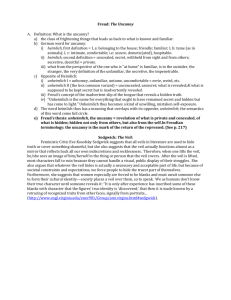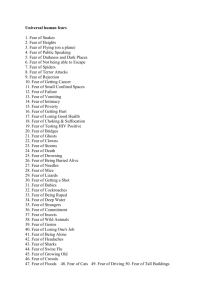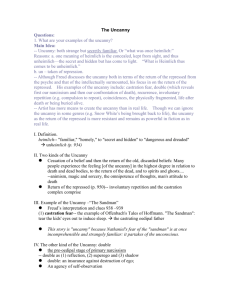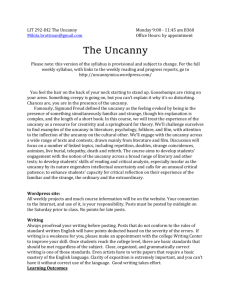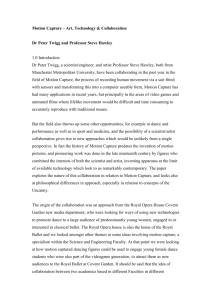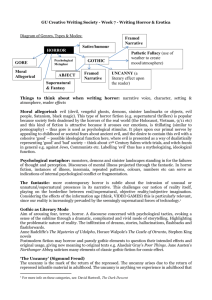Lecture Notes: Freud, "The Uncanny" (1919)
advertisement
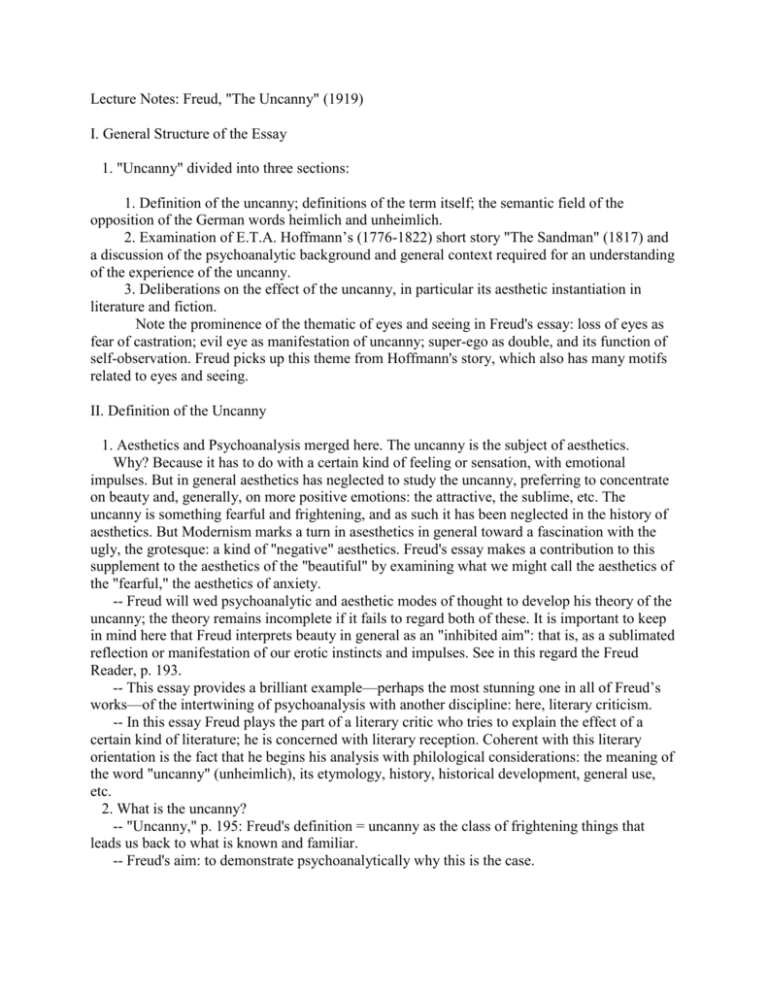
Lecture Notes: Freud, "The Uncanny" (1919) I. General Structure of the Essay 1. "Uncanny" divided into three sections: 1. Definition of the uncanny; definitions of the term itself; the semantic field of the opposition of the German words heimlich and unheimlich. 2. Examination of E.T.A. Hoffmann’s (1776-1822) short story "The Sandman" (1817) and a discussion of the psychoanalytic background and general context required for an understanding of the experience of the uncanny. 3. Deliberations on the effect of the uncanny, in particular its aesthetic instantiation in literature and fiction. Note the prominence of the thematic of eyes and seeing in Freud's essay: loss of eyes as fear of castration; evil eye as manifestation of uncanny; super-ego as double, and its function of self-observation. Freud picks up this theme from Hoffmann's story, which also has many motifs related to eyes and seeing. II. Definition of the Uncanny 1. Aesthetics and Psychoanalysis merged here. The uncanny is the subject of aesthetics. Why? Because it has to do with a certain kind of feeling or sensation, with emotional impulses. But in general aesthetics has neglected to study the uncanny, preferring to concentrate on beauty and, generally, on more positive emotions: the attractive, the sublime, etc. The uncanny is something fearful and frightening, and as such it has been neglected in the history of aesthetics. But Modernism marks a turn in asesthetics in general toward a fascination with the ugly, the grotesque: a kind of "negative" aesthetics. Freud's essay makes a contribution to this supplement to the aesthetics of the "beautiful" by examining what we might call the aesthetics of the "fearful," the aesthetics of anxiety. -- Freud will wed psychoanalytic and aesthetic modes of thought to develop his theory of the uncanny; the theory remains incomplete if it fails to regard both of these. It is important to keep in mind here that Freud interprets beauty in general as an "inhibited aim": that is, as a sublimated reflection or manifestation of our erotic instincts and impulses. See in this regard the Freud Reader, p. 193. -- This essay provides a brilliant example—perhaps the most stunning one in all of Freud’s works—of the intertwining of psychoanalysis with another discipline: here, literary criticism. -- In this essay Freud plays the part of a literary critic who tries to explain the effect of a certain kind of literature; he is concerned with literary reception. Coherent with this literary orientation is the fact that he begins his analysis with philological considerations: the meaning of the word "uncanny" (unheimlich), its etymology, history, historical development, general use, etc. 2. What is the uncanny? -- "Uncanny," p. 195: Freud's definition = uncanny as the class of frightening things that leads us back to what is known and familiar. -- Freud's aim: to demonstrate psychoanalytically why this is the case. -- Only previous study of the uncanny = that of Ernst Jentsch (1867-?), "On the Psychology of the Uncanny" (1906): Jentsch’s conclusions: 1) Uncanny = fear of the unfamiliar; 2) Uncanny = based on intellectual uncertainty. -- Freud will take issue with both of these propositions. -- Study of the German words, heimlich and unheimlich (canny/homey; uncanny/unhomey). heimlich, first definition = I, a: belonging to the house; friendly; familiar; I, b: tame (as in animals); I, c: intimate, comfortable; i.e: secure, dometic(ated), hospitable. heimlich, second definition = concealed, secret, withheld from sight and from others; secretive, deceitful = private. -- Note the dialectic of these meanings, summarized on p. 200: what from the perspective of the one who is "at home" is familiar, is to the outsider, the stranger, the very definition of the unfamiliar, the secretive, the impenetrable. -- The term heimlich embodies the dialectic of "privacy" and "intimacy" that is inherent in bourgeois ideology. Therefore Freud can associate it with the "private parts," the parts of the body that are the most "intimate" and that are simultaneously those parts subject to the most concealment (see p. 200). However, in Freud's understanding the "heimlich" will also be something that is concealed from the self. unheimlich: as the negation of heimlich, this word usually only applies to the first set of meanings listed above: unheimlich I = unhomey, unfamiliar, untame, uncomfortable = eerie, weird, etc. unheimlich II (the less common variant) = unconcealed, unsecret; what is made known; what is supposed to be kept secret but is inadvertently revealed. -- Note the implicit connection of this notion of the unheimlich to Freud’s concept of "parapraxis," the inadvertent slip of the tongue that reveals a hidden truth. Schelling’s definition (p. 199): "Unheimlich is the name for everything that ought to have remained secret and hidden but has come to light." Unheimlich thus becomes a kind of unwilling, mistaken self-exposure. In psychoanalytic terms, it provides a surprising and unexpected self-revelation. Freud concentrates on the unusual semantics of these 2 terms: heimlich I = known, familiar; unheimlich I = unknown, unfamiliar heimlich II = secret, unknown; unheimlich II = revealed, uncovered For a diagram of the complex semantic dynamics and oppositions Freud associates with these terms, click here. The word heimlich thus has a meaning that overlaps with its opposite, unheimlich; the semantics of this word come full circle. -- Freud's thesis: unheimlich, the uncanny = revelation of what is private and concealed, of what is hidden; hidden not only from others, but also from the self. In Freudian terminology: the uncanny is the mark of the return of the repressed. (See "Uncanny" 217) III. E.T.A. Hoffmann's "The Sandman" and the Psychoanalytic Elements of the Uncanny. 1. Jentsch's theory of the automaton: he sees the undecidability of the inanimate/animate opposition as one source of the uncanny. In Hoffmann's story this is embodied in the robotic woman Olympia. Jentsch sees this as the uncanny kernel of this text. -- Freud disagrees: he claims the source of the uncanny in this tale is the eponymous figure of the sandman himself. The sandman as a mythic figure who tears out children's eyes. 2. Story line of Hoffmann's "The Sandman": 1) Nathanial, the protagonist, is warned as a child about the sandman. The eerie Coppelius comes to conduct experiments with Nathaniel's father; Nathanial sees Coppelius and associates him with the sandman. Nathanial is discovered as he observes Coppelius and his father conducting alchemical experiments; Coppelius wants to burn his eyes out, but the father saves him. Nathaniel's father is later killed by an explosion during one of Coppelius's visits. 2) As a student, Nathanial meets the optician Coppola, from whom he buys a spy-glass. Nathanial falls in love with the automaton Olympia, whom he sees through this glass. Olympia has been produced by Spalanzani (double of the father) and Coppola (the double of Coppelius). Nathanial observes how the 2 fight over the automaton and the eyes are pulled out of the robot’s head. This fight between the two "fathers" repeats the fight that Coppelius and Nathaniel's father had over Nathaniel himself, when he was discovered spying on their experiments. (Note the significance of the structure of doubling in this story; we saw something similar in Kafka's "Country Doctor"). -- Nathanial falls into a state of insanity. 3) Nathanial recovers, and he is about to marry his fiancee Clara. They ascend the tower of the town hall and Nathaniel sees Coppelius through his spy-glass. He goes insane again and tries to kill Clara. Her brother rescues her, but Nathanial jumps off the tower to his death. The spyglass is a kind of symbol for the revelation of a hidden secret, for a tool that makes the heimlich (secret) unheimlich (unsecret). It allows Nathanial to penetrate into the sphere of the "private," but also to gain access to the repressed parts of his own past. 3. Freud's Interpretation: 1) Freud stresses the uncertainty of whether the events the narrator relates to us are real or imaginary; for uncanny fiction, this ambivalence will become decisive. (This is Freud's version of Jentsch's "intellectual uncertainty.") 2) For Freud the source of the uncanny is tied to the idea of being robbed of one's eyes. Why? Here Freud turns to the experience of the psychoanalyst: In dreams, myths, neurotic fantasies, etc. loss of the eyes = fear of castration. In "The Sandman" Coppelius, the "bad" father, interferes with all love relationships. He is the powerful, castrating father who supplants (kills) the good father who first protects Nathaniel's "eyes." 3) The uncanny thus marks the return of the familiar in the sense of our psychic economy (in which nothing is ever lost or wholly forgotten). It is the castration complex as part of our infantile sexuality (genital phase) that is re-invoked by the fear of loss of the eyes in this story. What is uncanny here is thus the return of something in our psychosexual history that has been overcome and forgotten. -- Freud's first thesis: The uncanny arises due to the return of repressed infantile material. 4) Other examples of this: The double (doppelganger); its source is the primary narcissism of the child, its self-love. In early childhood this produces projections of multiple selves. By doing this the child insures his/her immortality. But when it is encountered later in life, after childhood narcissism has been overcome, the double invokes a sensation of the uncanny = a return to a primitive state. 5) But Freud also relates the double to the formation of the super-ego. The super-ego projects all the things it represses onto this primitive image of the double. Hence the double in later life is experienced as something uncanny because it calls forth all this repressed content: -- Alternative meanings for this form of the double: a. it represents everything that is unacceptable to the ego, all its negative traits that have been suppressed; or b. it embodies all those utopian dreams, wishes, hopes that are suppressed by the reality principle, by the encounter with society. (See "Uncanny" 211-212) This aspect of Freud's theory will become important for our interpretation of Hofmannsthal's "A Tale of the Cavalry." WHY IS THE DOPPELGANGER THE PARADIGM OF THE UNCANNY? -- It represents a psychic “nodal point” with multiple implications, meanings, sources, etc. AMBIVALENCE: The Double Doubled “The fact that an agency of this kind [the super-ego] exists, which is able to treat the rest of the ego like an object--the fact, that is, that man is capable of self-observation--renders it possible to invest the old idea of a ‘double’ with a new meaning and to ascribe many things to it--above all, those things which seem to self-criticism to belong to the old surmounted narcissism of earlier times. But it is not only this latter material, offensive as it is to the criticism of the ego, which may be incorporated in the idea of a double. There are also all the unfulfilled but possible futures to which we still like to cling in phantasy, all the strivings of the ego which adverse circumstances have crushed [. . .].” “The Uncanny” (211-12; emphasis added) (This aspect of Freud’s theory will become important for our interpretation of Hofmannsthal’s “A Tale of the Cavalry.”) Freud's general thesis: The uncanny is anything we experience in adulthood that reminds us of earlier psychic stages, of aspects of our unconscious life, or of the primitive experience of the human species. a. castration b. double c. involuntary repetition; the compulsion to repeat (Wiederholungszwang) as a structure of the unconscious. d. animistic conceptions of the universe = the power of the psyche. It sees itself as stronger than reality; e.g. telepathy, mind over matter. These are common conceptions of primitive life. The uncanny arises as the recurrence of something long forgotten and repressed, something superceded in our psychic life = a reminder of our psychic past. IV. The Uncanny in Literature, in Narrative Fiction. A. Freud is not entirely satisfied with his own conclusion. Not everything that returns from repression is uncanny. Return of the repressed is a necessary condition for the uncanny, but not a sufficient one. Something else must also be at play here in order to create the experience of the uncanny. B. To understand this, Freud returns to the study of fiction for help. Here we find the 2 sources of the uncanny, its relation to the psychic past, confirmed: 1) uncanny = revival of repressed infantile material = part of individual psychic reality; 2) uncanny = confirmation or return of surmounted primitive beliefs of the human species, such as animism, etc. C. But Freud asks why our experience of the uncanny in our real-life experiences and in fiction are different. His answer (we know it already!) = fantasy is different from reality because it does not undergo reality-testing. -- Therefore, events that would be uncanny if experienced in real life are not experienced as such in fiction. Fairy tales, for example, give many instances of uncanny events that are not experienced by the reader as uncanny. Why? The readers adjust their sensibility to the fictional world. (See "Uncanny" 227) In other words, since uncanny events seem "normal" in the fairytale world, and we adjust our expectations to the "normal" state of this fictional reality, we as readers do not gain a sense of the uncanny. Or, we might say: since the characters in the fictional world of fairy tales do not see fantastic events as unusual or uncanny, but take them as a matter of course, the reader also is not led to find these things out of the "ordinary" (for the depicted world). -- Fiction only creates an uncanny effect if the author makes a pretense to realism; if we as readers believe that real, actual conditions are being narrated. -- The experience of the uncanny in literature depends on the discrepancy between real events and fantastic occurrences in the fictional world. The author promises truth and verisimilitude, but then breaks this promise. (See "Uncanny" 227) -- We, as readers of the fiction, must share the perspective of the character who experiences the uncanny event in the fictional world. See "Uncanny" 229, the example of the severed hand. -- In Hoffmann's "The Sandman," the narrator makes us look through the spy-glass Nathaniel buys from Coppola/Coppelius, the demon optician. (See "Uncanny" 205-206). V. Summary of the Qualities of Uncanny Fiction A. Focus is on one central character = the anchor character; events, people, etc. in the fictional world only have significance in relation to this character. It forms the hub, or center of all events. B. External events are seen through the perspective of the anchor character and colored by his or her psyche; they are projections of the psyche of this fictional character. C. The text thus takes on the quality of a dream text, with manifest and latent content. The real and the fantastic (Freud's required ambivalence) form a unity in the consciousness of the anchor character. This lends some of the events the shimmer of the symbolic because it is undecidable whether they are real or imagined. D. Stylistically, uncanny fiction requires a fusion of objective and subjective narrative styles. We commonly find a realistic frame, which reads like a report or a newspaper article, which is suddenly ruptured by fantastic events. But this rupture is also related with the accuracy and detail of objective narration. E. The reader's perspective must be that of the anchor character; events must be perceived through his/her eyes, filtered through the psyche of this character. Only when all of these conditions are met is the experience of the uncanny transferred from the domain of the fictional world to the receptive experience of the reader.
